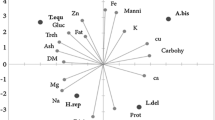Abstract
This study was conducted to determine the protein quality of four types ofedible mushrooms, Terfezia claveryi, Pleurotus ostreatus, Tricholoma terreum and Agaricus macrosporus that are common inJordan. Protein efficiency ratio (PER) and net protein utilization methods(NPU) were used. The four mushroom types failed to support growth asreflected by negative values for PER; –1.76 for T. claveryi; –0.23 for P. ostreatus; –0.98 for T. terreum and–0.41 for A. macrosporus. The NPU(op), NPU(st)and NdpE% for T. claveryi were 32.6, 33.9 and 3.89%,respectively. The respective values for P. ostreatus were 38.5, 40.7and 4.35%; T. terreum 29.1, 29.8 and 3.63%; and A.macrosporus 31.5, 32.9 and 3.91%. The results showed that the fourmushrooms were significantly (p ≤ 0.05) lower in protein qualitycompared with casein results (NPU(op), NPU(st) andNDpE% of 78.5, 86.4 and 7.16%, respectively.
Similar content being viewed by others
References
Phillips R (1985) Mushrooms and Other Fungi of Great Britain and Europe. London: Pan Books Ltd.
Rinker DL (1995) Commercial Mushroom Production. Ministry of Agriculture and Food, Ontario, USA.
Flegg PB, Maw GA (1977) Mushrooms and their possible contribution to world protein needs. Mushr J 48: 396–405.
Kibby G (1979) Mushrooms and Toadstools, A Field Guide. Oxford, New York: Oxford University Press.
Sawaya WN, Al-Shalhat A, Al-Sogair A, Al-Mohammed M (1985) Chemical composition and nutritive value of truffles of Saudi Arabia. J Food Sci 50: 450–453.
Natour RM, Salhab AS, El-Moumani AR, Saba EF (1992) Wild mushrooms in Jordan. Dirasat 19B(2): 47–60.
Boras M (1996) Mushroom as a new source for food and its role in food security. Agric Devel 15(1): 40–48 (in Arabic).
Ahmed AA, Mostafa AM, Hami MA (1981) Libyan truffles 'Terfezia boudieri Chatin': Chemical composition and toxicity. J Food Sci 46: 927–929.
Ibrahim NA, Saeed AA (1994) Protein content and amino acid analysis of the desert truffles. Ann Agric Sci Moshtohor 32(3): 1569–1573.
Pellett PL, Shadarevian S (1970) Food Composition Tables for Use in The Middle East. Beirut, Lebanon: American University of Beirut.
Takruri HR, Humeid MA, Umari MA (1990) Protein quality of parched immature durum wheat (Frekeh). J Sci Food Agric 50: 319–327.
Lane-Petter W, Pearson AEG (1971) The Laboratory Animal Principle and Practices. London: Academic Press.
AOAC (1995) Official Methods of Analysis, 16th edn. Washington, DC: Association of Official Analytical Chemists.
Pellett PL, Young VR (1980) Nutritional Evaluation of Protein Foods. Japan: United Nation University.
Steel RGD, Torrie JH (1980) Principles and Procedures of Statistics, 2nd edn. New York: McGraw-Hill Publ. Co.
Adewusi SRA, Alofe FV, Odeyemi O, Afolabi OA, Oke OL (1993) Studies on some edible wild mushrooms from Nigeria: 1. Nutritional, teratogenic and toxic considerations. Plant Food Hum Nutr 43: 115–121.
Pyssalo H, Niskanen A (1977) On the occurrence of N-Methyl-N Formylhydrazones in fresh and processed false morel, Gyromitra esculenta. J Agric Food Chem 25: 644–647.
Miller DS (1963) A procedure for determination of NPU using rats body nitrogen techniques. In: Evaluation of Protein Quality. Washington, DC: Nutritional Academy of Sciences, National Research Council Publication.
Laurena AC Van Den T, Mendoza EMT (1984) Effects of condensed tannins on in vitro digestibility of cowpea (Vigna unguiculata (L.) walp.). J Agric Food Chem 32: 1045–1048.
DaDamio PA, Thompson DB (1992) Mushroom (Agricus bisporus), its polyphenol oxidase, and polyphenolics affect in vitro iron availability. J Food Sci 57: 458–461.
Hurrell RF, Fiont PA (1982) Protein-polyphenol reactions. 1. Nutritional and metabolic consequences of the reaction between oxidized caffeic acid and the lysine residues of casein. Br J Nutr 47: 191–211.
Sarware G, McDonough F (1990) Review of protein quality evaluation methods. J Assoc Off Anal Chem 73: 347–356.
Boutrif E (1991) Recent developments in protein quality evaluation. Food Nutr Agric 1: 36–40.
Food and Agricultural Organization of the United Nations (1991) Protein Quality Evaluation. Rome: FAO.
Bano Z, Rajarantham S (1988) Pleurotus mushrooms. Part II. Chemical composition, nutritional value, post harvest physiology, preservation and role as human food. CRC Crit Rev Food Sci Nutr 27: 87–158.
Tshinyangu KK (1996) Effect of grass hay substrate on nutritional value of Pleurotus ostreatus var Columbinus. Nahrung 40: 79–83.
Author information
Authors and Affiliations
Rights and permissions
About this article
Cite this article
Dabbour, I.R., Takruri, H.R. Protein quality of four types of edible mushrooms found in Jordan. Plant Foods Hum Nutr 57, 1–11 (2002). https://doi.org/10.1023/A:1013166623496
Issue Date:
DOI: https://doi.org/10.1023/A:1013166623496




